Research on the Improvement of BEM Method for Ultra-Large Wind Turbine Blades Based on CFD and Artificial Intelligence Technologies
Abstract
1. Introduction
2. Numerical Scheme
2.1. CFD Calculate
2.2. Artificial Intelligence Approaches
2.3. Improved BEM
3. Results and Discussion
4. Conclusions
Author Contributions
Funding
Data Availability Statement
Conflicts of Interest
Abbreviations
| Incoming wind speed | |
| Axial velocity at the position of the wind rotor | |
| Axial-induced velocity at the position of the wind wheel | |
| a | Axial induction factor |
| b | Tangential induction factor |
| Tangential velocity at the position of the wind rotor | |
| Ω | The rotation speed of the wind rotor |
| Thrust of wind rotor | |
| Torque of wind rotor | |
| ρ | Air density |
| The output value of layer k | |
| The input value of layer k | |
| Activation function | |
| The weight of the i-th neuron in the k-th layer | |
| The bias value of the i-th neuron in the k-th layer | |
| The predicted output value obtained | |
| The actual output value | |
| φ | Inflow angle |
| α | Attack angel |
| Lift coefficient | |
| Drag coefficient | |
| Normal force coefficient | |
| Tangential force coefficient | |
| Opt_BEM | The optimized BEM |
| Opt_dT | The thrust value at the blade element location obtained from the optimized BEM calculations |
| Opt_dM | The torque value at the blade element location obtained from the optimized BEM calculations |
| BEM_dT | The thrust value at the blade element location obtained from the classical BEM calculations |
| BEM_dM | The torque value at the blade element location obtained from the classical BEM calculations |
| Er,Opt_BEM | The relative error between the optimized BEM and the RANS calculated values |
| Er,BEM | The relative error between the traditional BEM and the RANS calculated values |
| ΔEr,max | The maximum value of the relative error change |
| ΔEr,min | The minimum value of the relative error change |
| ΔEr,mean | The mean value of the relative error change |
| n | sample size |
| The value of the kth prediction | |
| The value of the kth measurement | |
| Absolute values of calculated values obtained by different calculation methods | |
| The calculated values obtained by the RANS calculation method |
References
- Schmitz, S. Aerodynamics of Wind Turbines; Wiley: Hoboken, NJ, USA, 2020. [Google Scholar]
- Hartwanger, D.; Horvat, A. 3D Modelling of a Wind Turbine Using CFD. In Proceedings of the NAFEMS UK Conference 2008 “Engineering Simulation: Effective Use and Best Practice”, Cheltenham, UK, 10–11 June 2008. [Google Scholar]
- Ferrer, E.; Munduate, X. Wind turbine blade tip comparison using CFD. J. Phys. Conf. Ser. 2007, 75, 012005. [Google Scholar] [CrossRef]
- Sorensen, N.; Michelsen, J. Aerodynamic Predictions for the Unsteady Aerodynamics Experiment Phase-II Rotor at the National Renewable Energy Laboratory. In Proceedings of the 2000 ASME Wind Energy Symposium, Reno, NV, USA, 10–13 January 2000. [Google Scholar]
- Nachtane, M.; Tarfaoui, M.; Goda, I.; Rouway, M. A review on the technologies, design considerations and numerical models of tidal current turbines. Renew. Energy 2020, 157, 1274–1288. [Google Scholar] [CrossRef]
- Whale, J.; Anderson, C.; Bareiss, R.; Wagner, S. An experimental and numerical study of the vortex structure in the wake of a wind turbine. J. Wind. Eng. Ind. Aerodyn. 2000, 84, 1–21. [Google Scholar] [CrossRef]
- Lee, H.; Sengupta, B.; Araghizadeh, M.S.; Myong, R.S. Review of vortex methods for rotor aerodynamics and wake dynamics. Adv. Aerodyn. 2022, 4, 20. [Google Scholar] [CrossRef]
- Wang, T.; Zhong, W.; Qian, Y.; Zhu, C. Computational Models of Vortex Wake. In Wind Turbine Aerodynamic Performance Calculation; Springer Nature: Singapore, 2023; pp. 133–152. [Google Scholar]
- Xu, B.; Feng, J.; Wang, T.; Yuan, Y.; Zhao, Z. Application of a turbulent vortex core model in the free vortex wake scheme to predict wind turbine aerodynamics. J. Renew. Sustain. Energy 2018, 10, 023303. [Google Scholar] [CrossRef]
- Xu, B.; Liu, B.; Cai, X.; Yuan, Y.; Zhao, Z.; Wang, Y. Accuracy of the aerodynamic performance of wind turbines using vortex core models in the free vortex wake method. J. Renew. Sustain. Energy 2019, 11, 053307. [Google Scholar] [CrossRef]
- Schepers, J.G. Engineering Models in Wind Energy Aerodynamics. Ph.D. Thesis, Delft University of Technology, Delft, The Netherlands, 2012. [Google Scholar]
- Shen, W.Z.; Zhu, W.J.; Sørensen, J.N. Study of tip loss corrections using CFD rotor computations. J. Phys. Conf. Ser. 2014, 555, 012094. [Google Scholar] [CrossRef]
- Zhong, W.; Shen, W.; Wang, T.; Li, Y. A tip loss correction model for wind turbine aerodynamic performance prediction. Renew. Energy 2020, 147, 223–238. [Google Scholar] [CrossRef]
- Leishman, J.G.; Beddoes, T.S. A Generalised Model for Airfoil Unsteady Aerodynamic Behaviour and Dynamic Stall Using the Indicial Method. In Proceedings of the 42nd Annual forum of the American Helicopter Society, Washington, DC, USA, 2–5 June 1986; Volume 34. [Google Scholar]
- Liu, X.; Liang, S.; Li, G.Q.; Godbole, A.; Lu, C. An improved dynamic stall model and its effect on wind turbine fatigue load prediction. Renew. Energy 2020, 156, 117–130. [Google Scholar] [CrossRef]
- Chaviaropoulos, P.K.; Hansen, M.O.L. Investigating three-dimensional and rotational effects on wind turbine blades by means of a quasi-3D Navier-Stokes solver. J. Fluids Eng. 2000, 122, 330–336. [Google Scholar] [CrossRef]
- Zhao, Q.; Li, W.; Yao, X.J.; Shao, Y.; Guo, Q. Optimization of wind turbine Angle of attack and cone Angle and their correlation. J. Shenyang Univ. Technol. 2019, 41, 495–500. [Google Scholar]
- Baisthakur, S.; Fitzgerald, B. Physics-Informed Neural Network surrogate model for bypassing Blade Element Momentum theory in wind turbine aerodynamic load estimation. Renew. Energy 2024, 224, 120122. [Google Scholar] [CrossRef]
- Abutunis, A.; Hussein, R.; Chandrashekhara, K. A neural network approach to enhance blade element momentum theory performance for horizontal axis hydrokinetic turbine application. Renew. Energy 2019, 136, 1281–1293. [Google Scholar] [CrossRef]
- Verma, N.; Baloni, B.D. Artificial neural network-based meta-models for predicting the aerodynamic characteristics of two-dimensional airfoils for small horizontal axis wind turbine. Clean Technol. Environ. Policy 2022, 24, 563–577. [Google Scholar] [CrossRef]
- Ke, S.; Lu, M.; Wu, H.; Gao, M.; Tian, W. Based on wind tunnel test 15 MW wind turbine blade flutter morphology and energy profile. J. Aerodyn. 2022, 40, 169–180. [Google Scholar]
- Cao, J.; Qin, Z.; Ju, Y.; Chen, Y.; Shen, W.Z.; Shen, X.; Ke, S. Study of air compressibility effects on the aerodynamic performance of the IEA-15 MW offshore wind turbine. Energy Convers. Manag. 2023, 282, 116883. [Google Scholar] [CrossRef]
- Burton, T.; Jenkins, N.; Sharpe, D.; Bossanyi, E. Wind Energy Handbook; John Wiley & Sons, Ltd.: Hoboken, NJ, USA, 2011. [Google Scholar] [CrossRef]
- Betz, A. Schraubenpropeller mit Geringstem Energieverlust. In Göttingen Nachrichten; Dissertation; Vandenhoeck & Ruprecht: Göttingen, Germany, 1919. [Google Scholar]
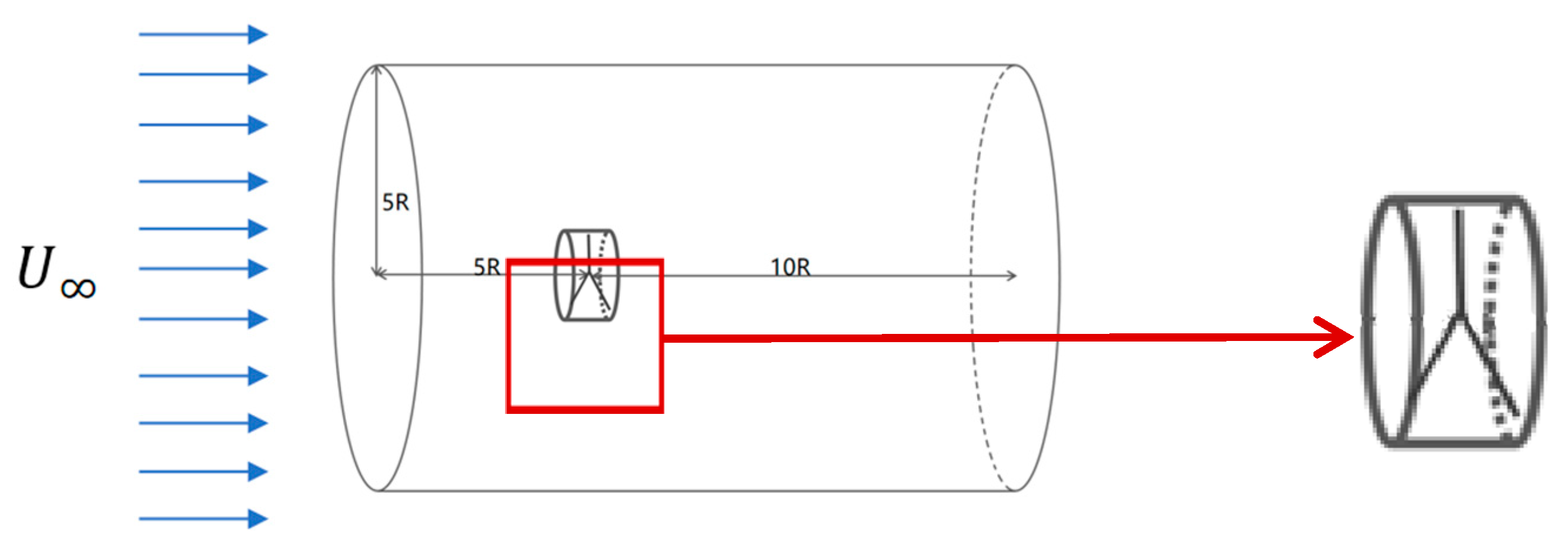
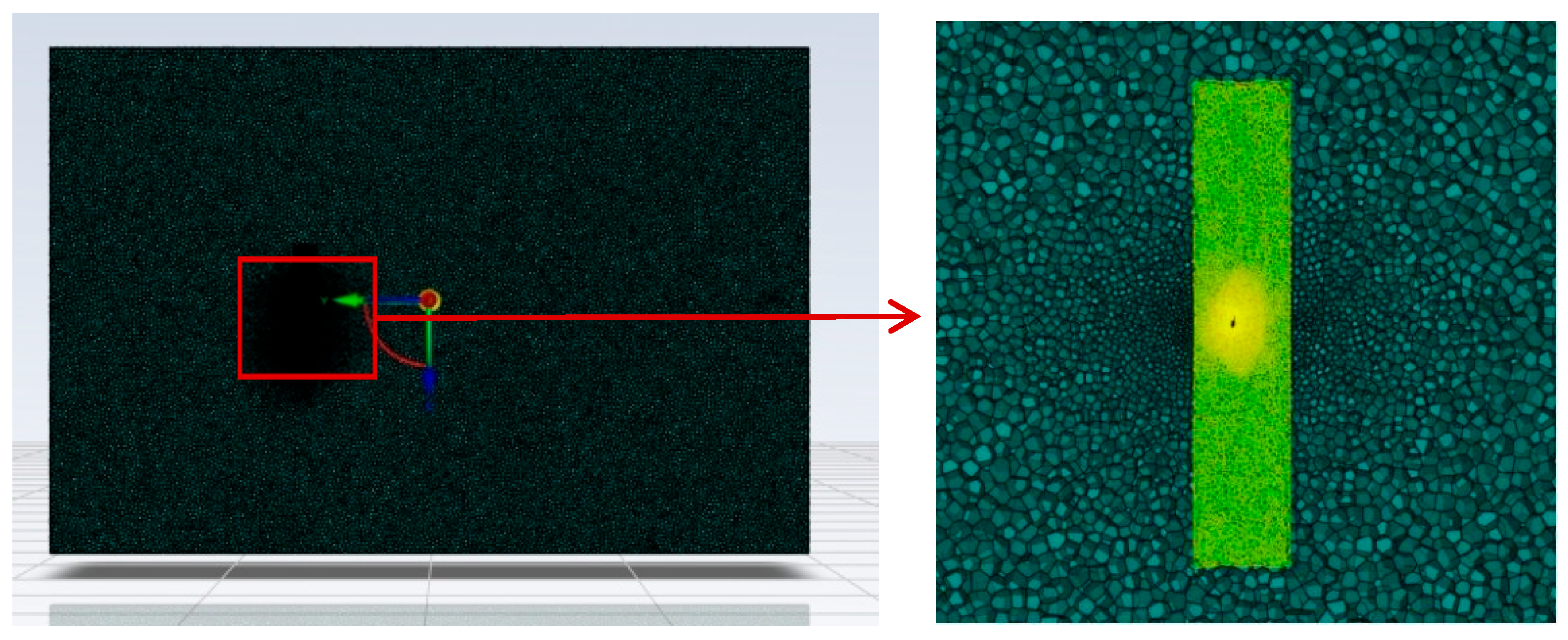
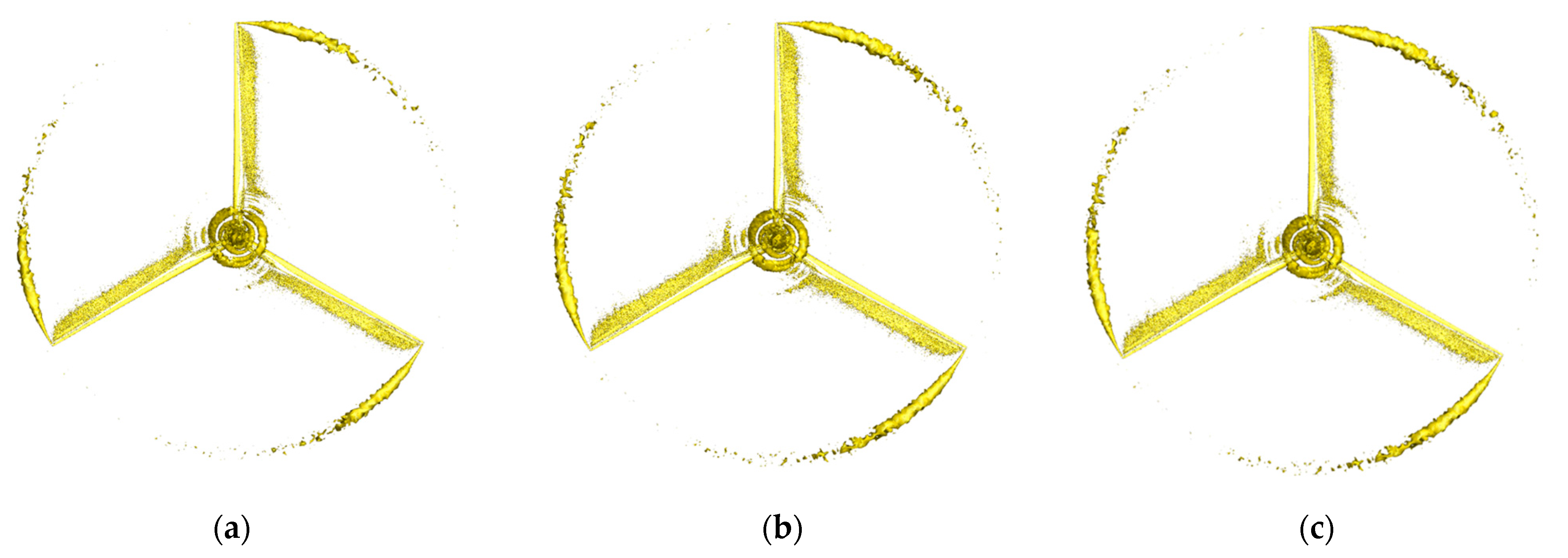
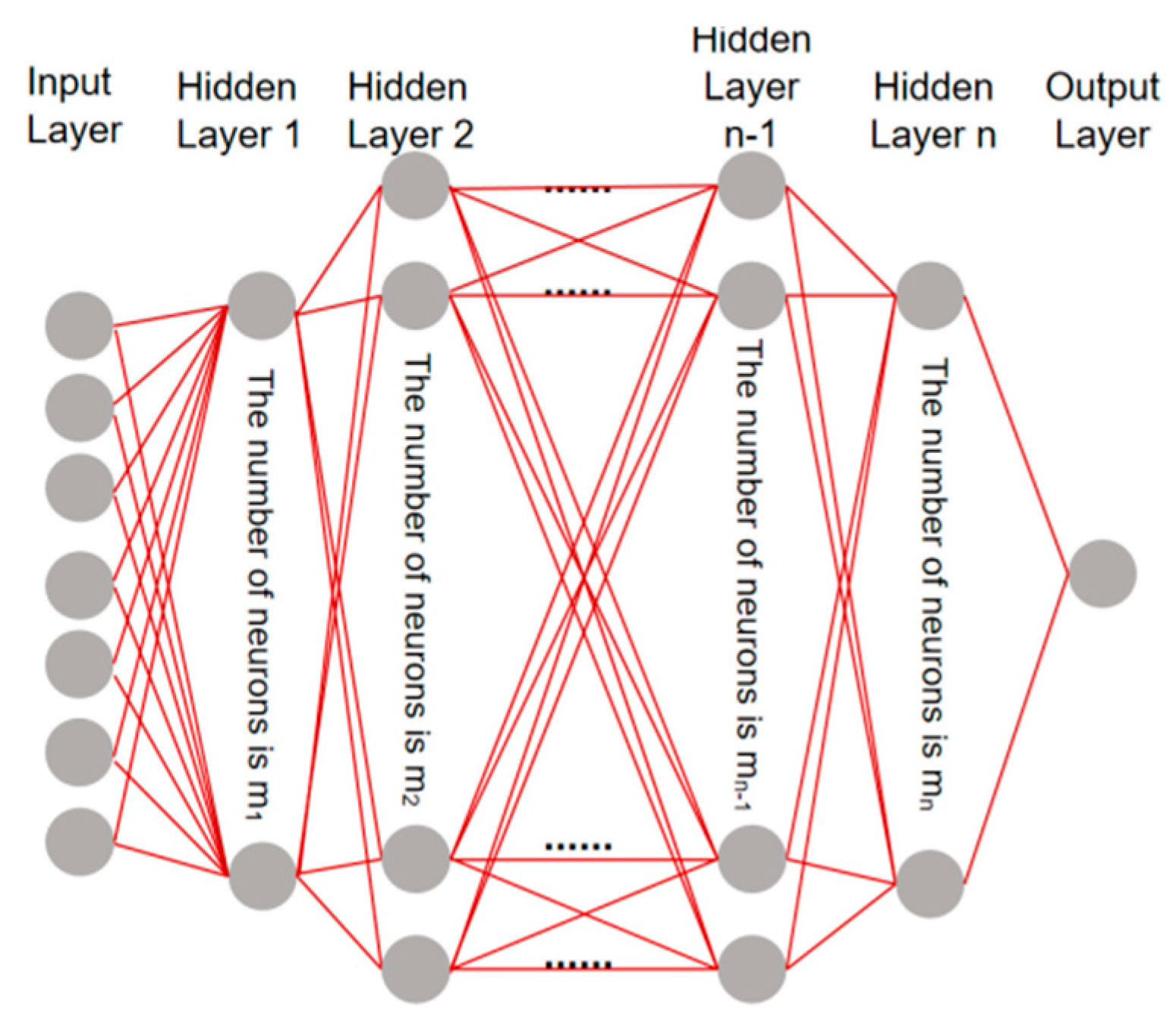



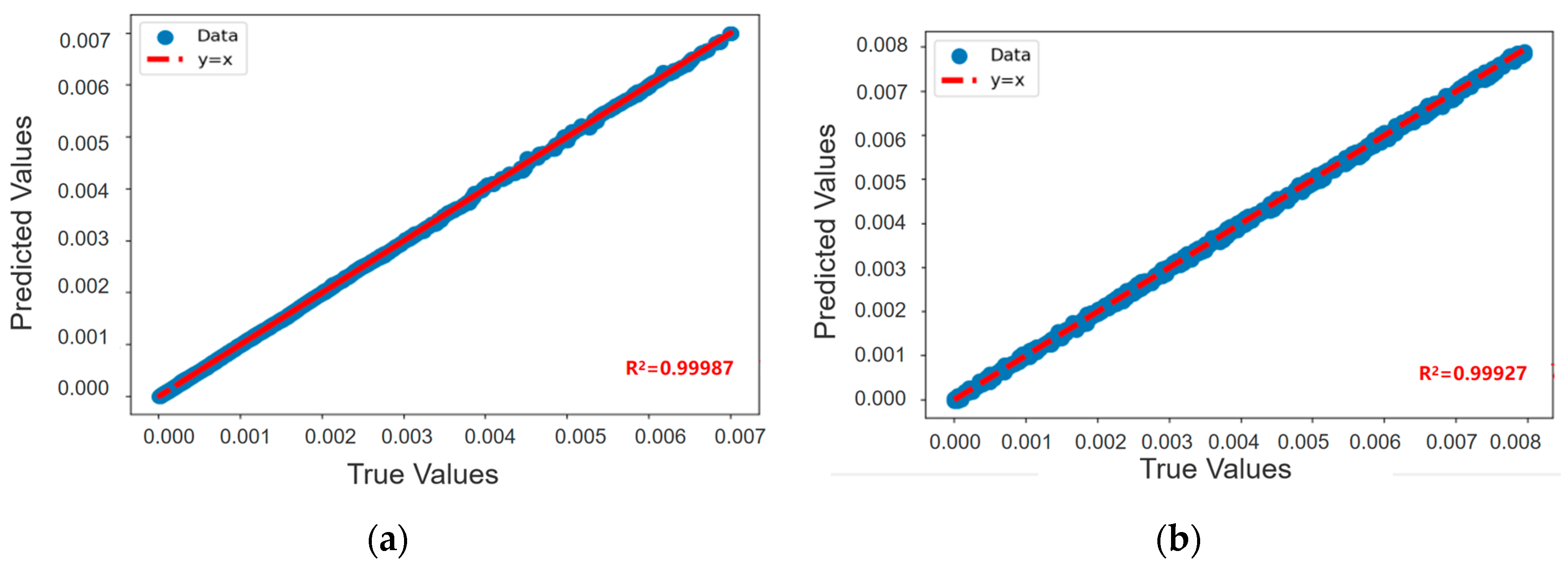
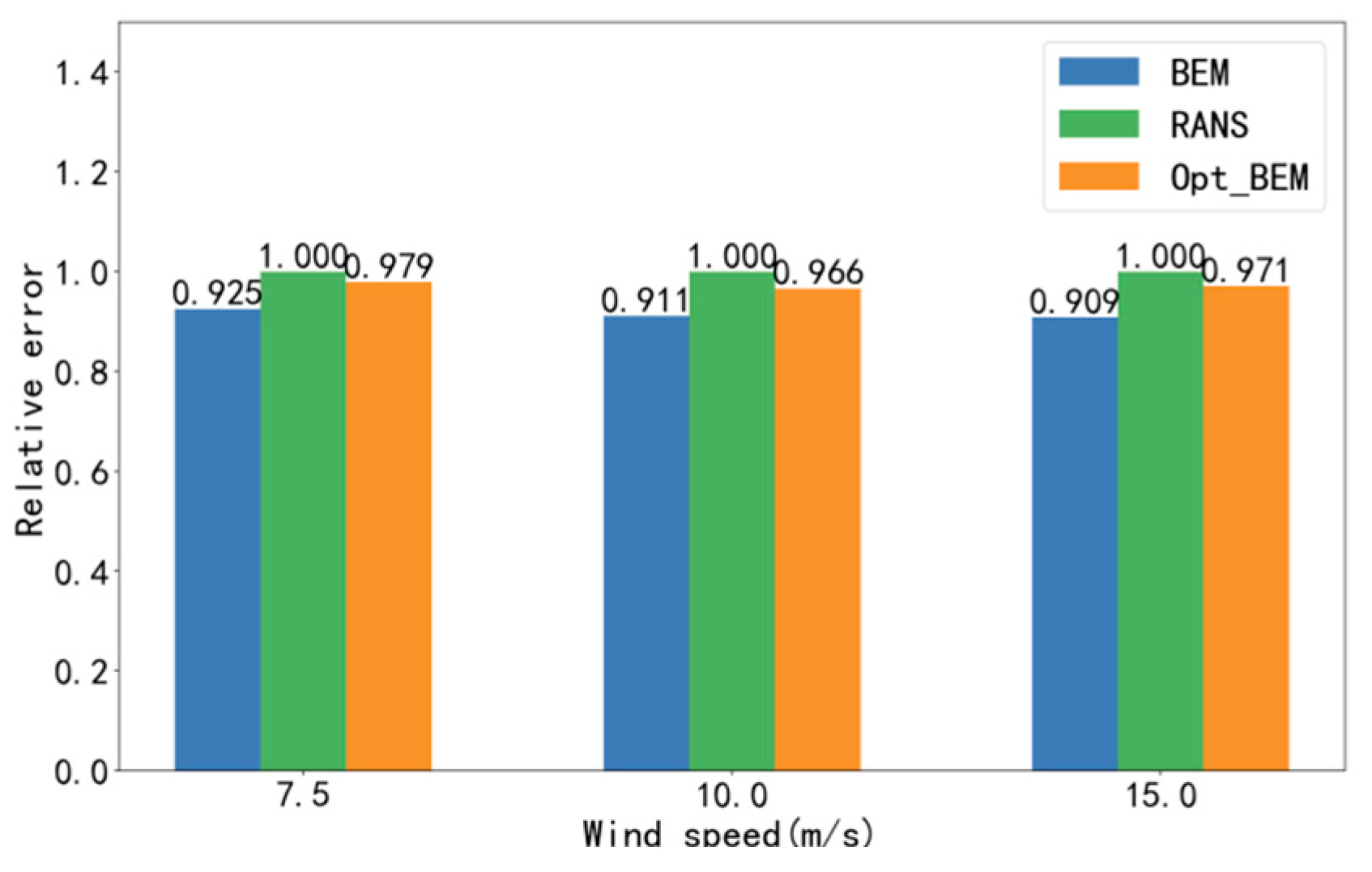
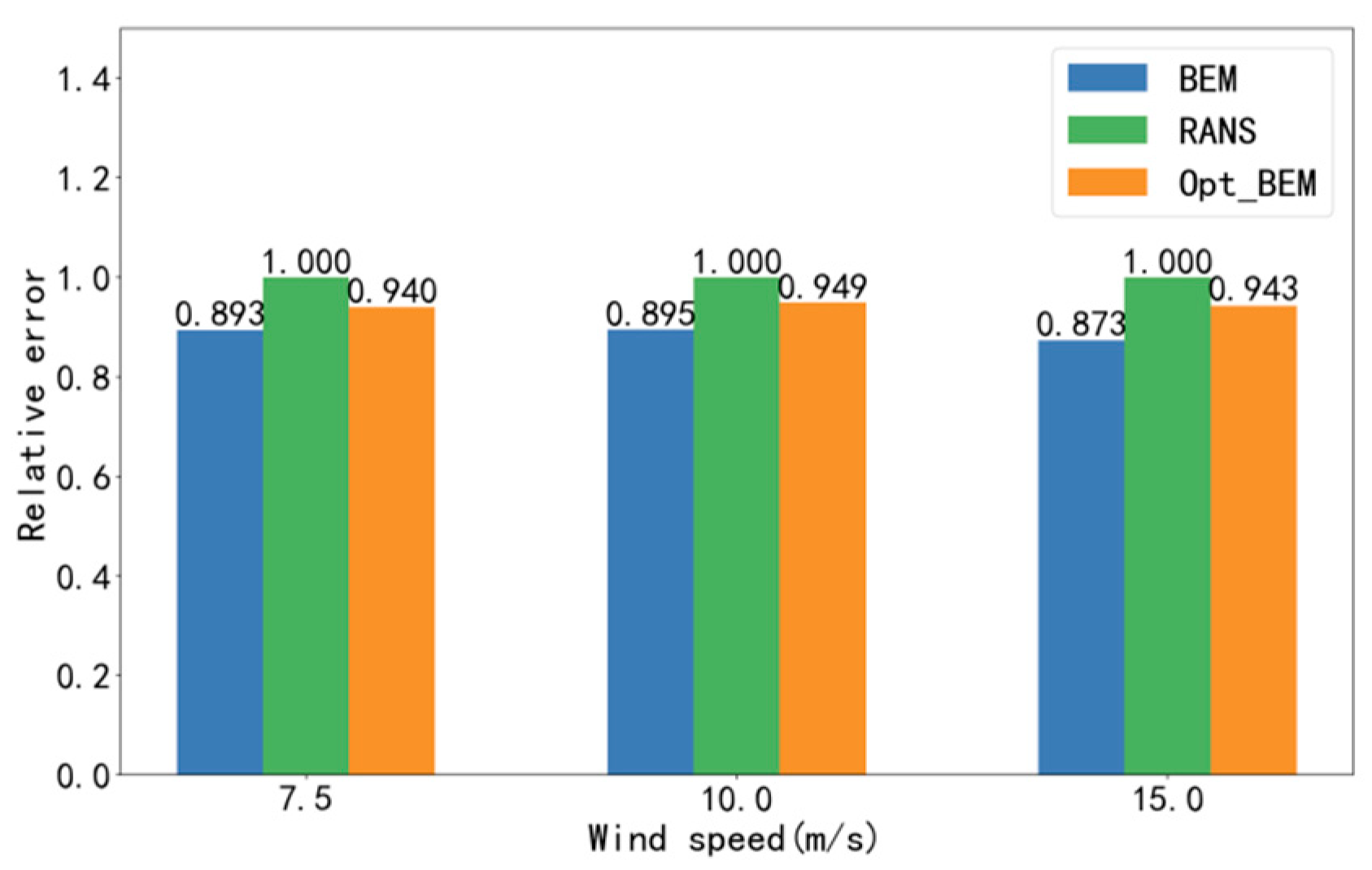

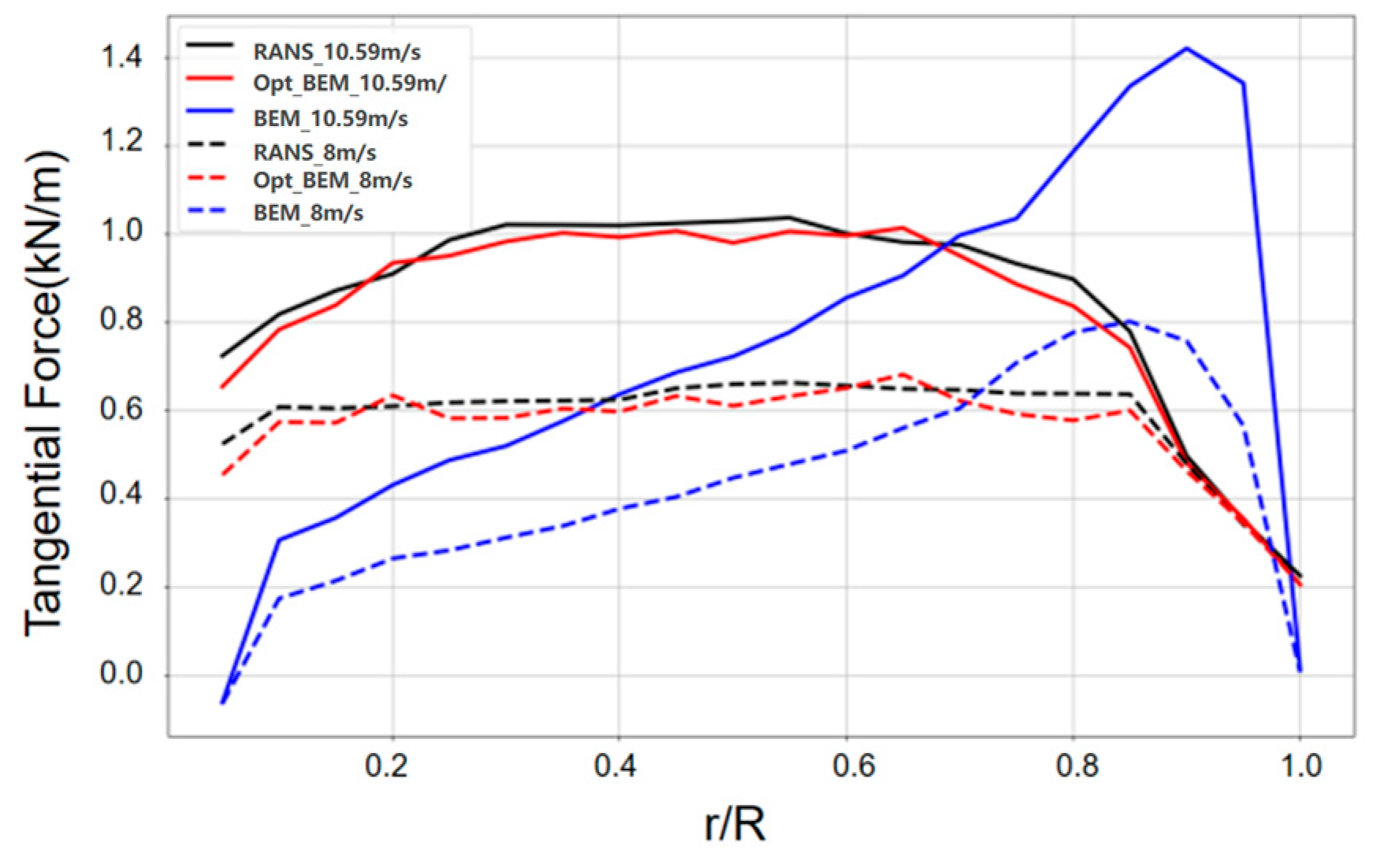

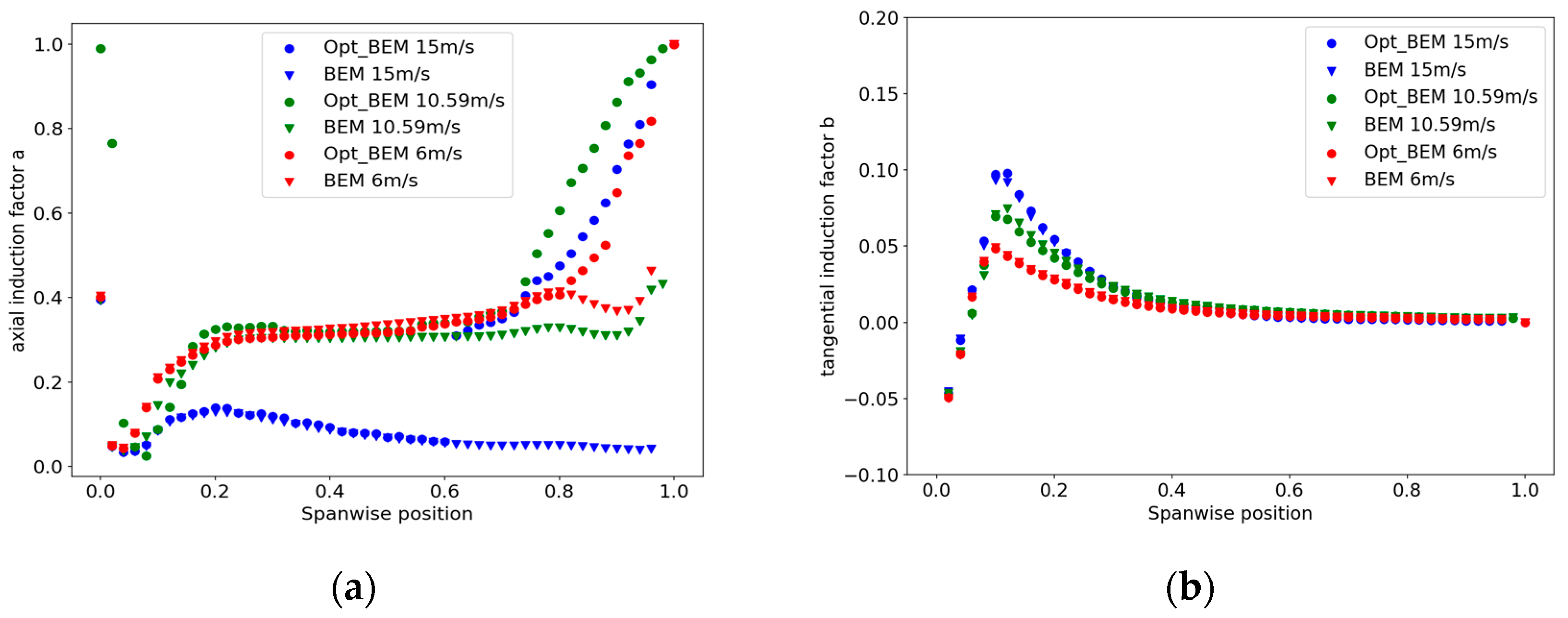
| Parameter | Value | Parameter | Value |
|---|---|---|---|
| Rated Power | 15 MW | Tip Speed Ratio | 9 |
| Number of Blades | 3 | Maximum Tip Speed | 95 m/s |
| Cut-in Wind Speed | 3 m/s | Rotor Diameter | 240 m |
| Rated Wind Speed | 10.59 m/s | Blade Length | 117 m |
| Cut-out Wind Speed | 25 m/s | Hub Diameter | 7.94 m |
| Minimum Rotational Speed | 5 RPM | Root Diameter | 5.2 m |
| Maximum Rotational Speed | 7.56 RPM | Maximum Chord Length | 5.77 m |
| Mesh | Number of Grids | Thrust (MN) | Torque (MNm) |
|---|---|---|---|
| M1 | 13 million | 2.04 | 16.8 |
| M2 | 17.43 million | 2.15 | 18.7 |
| M3 | 23.63 million | 2.18 | 18.8 |
| Working Condition | Wind Speed [m/s] | Rotor Speed [rpm] | Working Condition | Wind Speed [m/s] | Rotor Speed [rpm] |
|---|---|---|---|---|---|
| Case1 | 4 | 5 | Case13 | 11 | 7.56 |
| Case2 | 5 | 5 | Case14 | 12 | 7.56 |
| Case3 | 6 | 5 | Case15 | 13 | 7.56 |
| Case4 | 6.73 | 5 | Case16 | 14 | 7.56 |
| Case5 | 7.16 | 5.09 | Case17 | 16 | 7.56 |
| Case6 | 7.50 | 5.33 | Case18 | 17 | 7.56 |
| Case7 | 8.18 | 5.87 | Case19 | 19 | 7.56 |
| Case8 | 8.71 | 6.19 | Case20 | 20 | 7.56 |
| Case9 | 9.38 | 6.67 | Case21 | 21 | 7.56 |
| Case10 | 9.78 | 6.94 | Case22 | 22 | 7.56 |
| Case11 | 10.20 | 7.25 | Case23 | 23 | 7.56 |
| Case12 | 10.59 | 7.56 | Case24 | 24 | 7.56 |
| Wind Speed [m/s] | Name of the Errors | Type of Errors | Numerical Value |
|---|---|---|---|
| 8 m/s | Er,Opt_BEM | ΔEr,max | 6.87% |
| ΔEr,min | 0.5% | ||
| ΔEr,mean | 3.59% | ||
| Er,BEM | ΔEr,max | 36.49% | |
| ΔEr,min | 1.92% | ||
| ΔEr,mean | 20.32% | ||
| 10.59 m/s | Er,Opt_BEM | ΔEr,max | 9.30% |
| ΔEr,min | 0.36% | ||
| ΔEr,mean | 2.65% | ||
| Er,BEM | ΔEr,max | 53.82% | |
| ΔEr,min | 0.80% | ||
| ΔEr,mean | 18.21% |
| Wind Speed [m/s] | Name of the Errors | Type of Errors | Numerical Value |
|---|---|---|---|
| 8 m/s | Er,Opt_BEM | ΔEr,max | 13.3% |
| ΔEr,min | 0.83% | ||
| ΔEr,mean | 6.33% | ||
| Er,BEM | ΔEr,max | 112.06% | |
| ΔEr,min | 6.4% | ||
| ΔEr,mean | 53.64% | ||
| 10.59 m/s | Er,Opt_BEM | ΔEr,max | 9.63% |
| ΔEr,min | 0.54% | ||
| ΔEr,mean | 4.55% | ||
| Er,BEM | ΔEr,max | 108.43% | |
| ΔEr,min | 2.18% | ||
| ΔEr,mean | 53.3% |
Disclaimer/Publisher’s Note: The statements, opinions and data contained in all publications are solely those of the individual author(s) and contributor(s) and not of MDPI and/or the editor(s). MDPI and/or the editor(s) disclaim responsibility for any injury to people or property resulting from any ideas, methods, instructions or products referred to in the content. |
© 2025 by the authors. Licensee MDPI, Basel, Switzerland. This article is an open access article distributed under the terms and conditions of the Creative Commons Attribution (CC BY) license (https://creativecommons.org/licenses/by/4.0/).
Share and Cite
Yang, S.; Zhang, M.; Feng, Y.; Jia, H.; Zhao, N.; Chen, Q. Research on the Improvement of BEM Method for Ultra-Large Wind Turbine Blades Based on CFD and Artificial Intelligence Technologies. Fluids 2025, 10, 112. https://doi.org/10.3390/fluids10050112
Yang S, Zhang M, Feng Y, Jia H, Zhao N, Chen Q. Research on the Improvement of BEM Method for Ultra-Large Wind Turbine Blades Based on CFD and Artificial Intelligence Technologies. Fluids. 2025; 10(5):112. https://doi.org/10.3390/fluids10050112
Chicago/Turabian StyleYang, Shiyu, Mingming Zhang, Yu Feng, Haikun Jia, Na Zhao, and Qingwei Chen. 2025. "Research on the Improvement of BEM Method for Ultra-Large Wind Turbine Blades Based on CFD and Artificial Intelligence Technologies" Fluids 10, no. 5: 112. https://doi.org/10.3390/fluids10050112
APA StyleYang, S., Zhang, M., Feng, Y., Jia, H., Zhao, N., & Chen, Q. (2025). Research on the Improvement of BEM Method for Ultra-Large Wind Turbine Blades Based on CFD and Artificial Intelligence Technologies. Fluids, 10(5), 112. https://doi.org/10.3390/fluids10050112






